Is there a way to expose a user's custom list via the API? If not then consider it a feature request :)
I noticed lists are displayed on the right side of the games so it is not really a privacy thing right?
jbn566's forum posts
This is a series of blogs based on my own personal game collection. I will attempt to go through them in a chronological order according to their release date. I will also attempt to play then on their original platform using the original controllers the game was designed for. If I am unable to get the system or the game working then I will use PC emulation or another platform emulation like the Intellivision Lives! game for the gamecube
Previous entries
9. Sega Master System's Great Baseball (1987) 10. Nintendo's Bases Loaded (1987) 11. Nintendo's R.B.I Baseball (1988) 12. Nintendo's Major League Baseball (1988) 13. Sega Master System's Reggie Jackson Baseball (1988) 14. TurboGrafx 16's World Class Baseball (1989) 15. Nintendo's Tecmo Baseball (1989) |
Baseball for Nintendo Gameboy (1989)
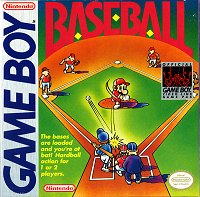
In the late 80’s Nintendo wasn’t happy with controlling the market share of the TV screen, they wanted to control the pocket. Nintendo created a mobile NES that anyone can hold and carry around with them, The system was call Game Boy and become one of the greatest systems every sold and released. With a new system out on the market, a new baseball would have to be released to make it a true success. Nintendo’s Gameboy game, Baseball, is not the first portable baseball game on this list but it is the first portable game where you play both sides of the sport. Microvision’s Baseball in 1983 was more or less a home run derby type game.
Graphics
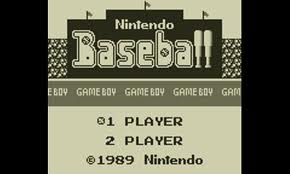
While it is not the first true portable baseball game based on the definition of the words it is the first to have a true video screen with graphics. The screen might be small and might be limited to only one color; the graphics are really not bad. Baseball takes its visual cue from more of the RBI baseball than the NES’s Baseball game. The pitching is behind the batter and the camera is closer to the field requiring scrolling when the ball is in the air. The pitcher and batter’s name is displayed during the pitch; the B/S/O is readable, using dots to represent the count I always prefer as I feel glancing at dots doesn’t force me to read text.
Field
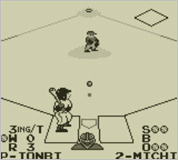
The field contains the basic of fields and everything normally found on the field including the foul lines, and batter's box. The system didn't support color so the field was more of the lack of color. The lines formed the field and defined the infield and outfield. The outfield contained a wall that displays the words 'Nintendo' on the center field much like the NES Baseball.
Players
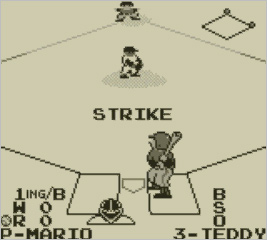
This is where the RBI baseball influence is shown the greatest. The batters and pitchers have that ‘round’ look to them. The batter’s helmet is detailed and has a shine to it along with an ear hole. Because the game boy lacked color the uniforms all look the same, one team just had a darker shirt. The batter’s pants contains a pinstripe down the side but because all the batter’s look the same makes it a generic experience. The catcher’s back is cut off and you only see the back of his mask and shoulders.
Scoreboard
There is no in game scoreboard during end of the innings. The only scoreboard that is displayed is on the title screen
Home Run Celebration
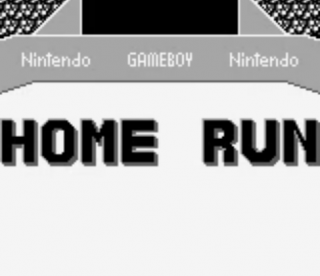
The celebration is pretty basic as well but a celebration does exist nevertheless. Once the ball lands in the stands, Big letters that stretch the width of the screen scrolls from the bottom to the center that spell ‘Home Run’ as well as nice melody.
Camera/Screen
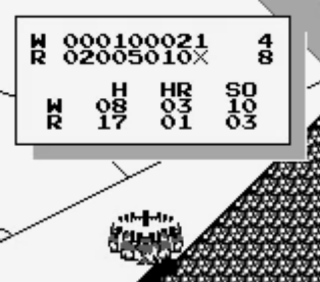
There are two cameras in use during the game. Behind the batter’s view during the pitches and another bird’s eye camera that follows the ball as it travels through the infield and outfield. There is a PnP of the infield at all times that helps see where the base runners are at the same time.
Menu
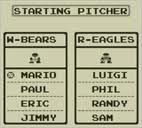
The menus are simple and easy to read. There is a menu to select which team you want to play and the pitcher. You can pitch hit as well as bring in a relief pitcher which displays a basic popup with a bare min information about the player
Sound
The background music is very catchy. It doesn’t make wish I had my ipod. There is no umpire voice or play by play. The sound effects such as the crowd, ball flying through the air is standard for typical baseball video games. The crowd noise is radio static and the ball flying through the air is a slide whistle.
Gameplay
Modes
There is only 2 modes for this game; 1 or 2 player single nine inning baseball game. Once you select the number of players you are able to select ‘USA mode’ or ‘JPN mode’ The only thing I can tell is the difference between these two modes is the names of the players on the team.
Defense
The game boy only has two buttons and not a whole lot of options. You control the fielder that is closest to the ball and you throw it to the bases to attempt to throw the runner out. The fielders in the game are wearing the same slow shoes as many game prior. I feel it takes forever to get to the ball. The throw isn’t very speedy either. The defense isn’t bad and doesn’t ruin the enjoyment of the game. You are able to move the pitcher and change direction of the pitch which provides a great deal of flexibility. Striking out the CPU was not impossible and a great feeling
Offense
The batter can move around in the batter’s box which is always helpful to make contact with the ball. Base running is standard as well. Nothing really innovated regarding the offense.
Rules of the Baseball

The game includes the 10 run mercy rule which exists in the little leagues but does not in MLB. Each team field 9 players and you are able to select the starting pitcher as well as pitch hit. There has yet been a game in this series where you can pitch run a base runner and I didn’t expect this game to advance the sport all the much. True fully the fact that I able to play a baseball video game in the car was all the rules I needed.
When you finish the game, a nice animation of the pitcher being lifted up and down is a nice effect as well as displays a game summary full of stats such as hits, home runs, and strike outs
Video Game Innovations
- Portable baseball game
@Claude: Thanks for that post. That really is a unique camera angle in the SNES game, Mode 7 anyone? I don't believe I have that game so I doubt I will be able to include it in this series. I might end up finding it by the time I get to that era of games though. One aspect of these games that I am looking forward to is when developers start putting a cursor on the fielders and or an estimate on where the ball might land. I think that innovation really helped the fielding in these games.
hi heatDrive88, Thanks for taking the time to read my blog post. Maybe I don't get your humor, I assume that 'Go fuck yourself' is a funny saying in your circle of friends and not sure how I can come back from that. I think you are mistaking the point of my blog posts. My history of baseball video games blogs is a series of blogs based on the baseball video games that I actually own and I am playing them in order of release. The number 11 assigned to RBI Baseball is not a rank, it is not in 11th place but more like the 11th baseball game released. If you are still confused please send me a message with less humor that I simply do not understand.
This is a series of blogs based on my own personal game collection. I will attempt to go through them in a chronological order according to their release date. I will also attempt to play then on their original platform using the original controllers the game was designed for. If I am unable to get the system or the game working then I will use PC emulation or another platform emulation like the Intellivision Lives! game for the gamecube
Previous entries
9. Sega Master System's Great Baseball (1987) 10. Nintendo's Bases Loaded (1987) 11. Nintendo's R.B.I Baseball (1988) 12. Nintendo's Major League Baseball (1988) 13. Sega Master System's Reggie Jackson Baseball (1988) 14. TurboGrafx 16's World Class Baseball (1989) |

After the introduction of a 16-bit baseball game in the previous blog, there is still a lot of 8-bit games still being developed and released. 1989 through 1992 were transitional years for the industry where developers produced games for old systems with established installed base andwell as produce games for the sexy, state of the art platforms such as the TurboGrafx-16. Tecmo Baseball was released only on the Nintendo Entertainment System in 1989. Tecmo was a popular sports video game development house, most famous for the Tecmo Bowl football game. Is there a reason why Tecmo Baseball isn’t on the same level? Let’s find out.
Graphics
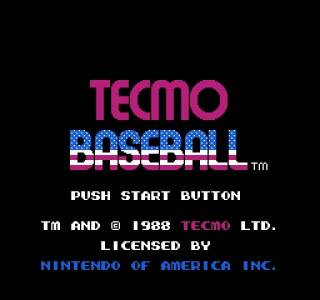
I will be honest, maybe it is because I have been playing a lot of NES baseball games as of late, but this game comes across as very generic. It almost appears as though the development team took what they thought was great about the previous released baseball games and put them into this game. There are elements of Bases Loaded, Baseball and RBI Baseball. Overall the graphics and presentation is not really bad just felt as though I have seen and played this game before.
Field
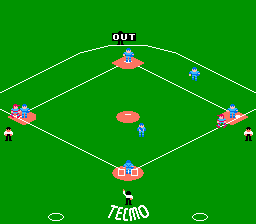
We are back in the 8-bit world so we lose textures and forced to play on solid green fields. Once again we have a baseball game where the infield dirt is only around the bases and not part of the base paths. There is no first base running path line and the bases and home plate are displayed correctly. The pitcher’s mound doesn’t appear to have height to it. Tecmo is great at inserting their own name into their games. One such way was including their name on the green grass directly behind home plate for the field camera as well as on the back stop wall for the behind the pitcher view. No matter which camera is showing the game, the words ‘Tecmo’ is there to help remind you what game you are playing.
Players
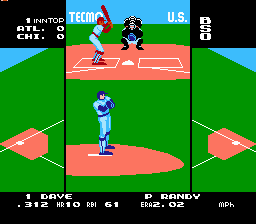
During the behind the pitcher view the players look really stiff, the players are lean and not chubby like R.B.I Baseball and looks like a slightly enhanced version of Bases Loaded. The batter and pitcher have eyes on their faces as well as stirrups but their feet are huge; I am talking clown shoe size. Because of the behind the pitcher view the pitcher is larger and closer to the camera and thus more detail has been applied to them. There is actually some shadowing effects going on with the pitcher’s uniform. There also lacks numbers on the uniforms which adds to the feeling of generic fielders and base runners.
Scoreboard
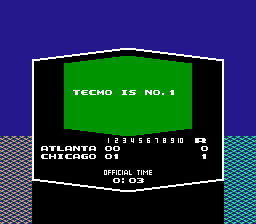
Did I mention the word ‘generic’ in the blog yet. If not then let me reserve that word to describe the scoreboard. I don’t really understand this scoreboard; there is a huge green jumbotron that appears to a waste of space majority of the time. In-between the innings the jumbotron shows random sayings and sentences that doesn’t seem to be based on anything. Examples of things that might appear in the center of the jumbotron is ‘Big Hit’, ‘Tecmo is number 1’, ‘Fight’. Besides the green jumbotron the scoreboard did include the scoring summary per inning. It lacked stats such as hit count, errors as well as the lineup.
Fans
I am not even going to detail the crowd in this game. They literally took the 1983 baseball game and copied the pattern. It’s ugly.
Home Run Celebration
Now here is where I can see the influence of Bases Loaded in the game. This game took the home run animation of Bases Loaded and applied minor, very minor changes to it. In Bases loaded the batter is displayed on the scoreboard’s jumbotron rounding 2 base in the background as the pitcher is kneeling down in disgust. This game the camera is reversed and the batter is in the foreground with the pitcher behind him. When the batter approaches the dugout he high fives his teammates the same way Bases Loaded animated it.
| Tecmo Baseball | Bases Loaded |
|---|---|
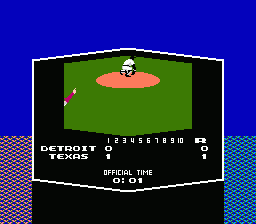 | 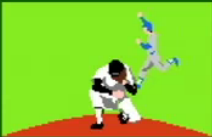 |
Camera/Screens

The screen during the pitching was influenced by R.B.I baseball; 1 base and 3 base camera is always displayed and takes up 1/3 of the screen each. The main camera is behind the pitcher unlike RBI’s behind the batter view. This setup was weird for me because while there was a camera on 1 and 3, if there was a runner on second you can just see the back of their uniform poking out from the bottom of the screen. You couldn’t see 2 base and hard to gauge how far off the base they are standing to pick them off. The fielding camera did contain an overhead view of the diamond and I felt like I would like to see that during the pitching. The main camera did display the pitcher and batter’s name and stats such as ERA, home run and RBI count as well as batting average.
Menu
There is no editing of the lineup and roster in the game so the use of menu is less important. During pitch hitting and calling for a relief pitcher, the screen switches to a solid black background and white text. Not ugly but not the most colorful or exciting.
Sounds
The melody of the background music is catchy and enjoyable, Tecmo games usually contain catchy music and this one is up to their standard. The umpires only says the basic words of ‘strike’, ‘out’, and ‘safe’
Gameplay
Modes
- 1 player mode – pick a team and complete the tecmo series
- 2 player mode
- 1 player All-Star – play as a team with great stats
- 2 player All-Star
- Watch mode
Defense
This game does some innovating regarding fielding in which if you press the A+B buttons together the fielder jumps and dives. It is enjoyable to watch and perform, like in real life though if you miss the ball the runner has enough time to advance to the next base. The fielding doesn’t feel slow like previous games but because the outfield is so huge I feel like the fielders have to travel a great deal to collect the ball. I can move the pitcher left and right and feel the strike zone is fairly large and was able to strike many batters out.
Offense
The batting is standard for the course for Nintendo games. Because the behind the pitcher view, the batter was unable to move up and down within the batter’s box only left or right. To control the base runners a simple tab of the base the runner is on was all it took. I didn’t find myself confused with the controls. A lot can be said about maintaining a standard gameplay mechanic in video games.
Rules of Baseball
One aspect of MLB that I haven’t really seen in video games is the MLB’s American League’s DH rule. Before you start each game you have the option to use or don’t use the DH rule in the game. One rule that I continually see absent from these video games is the infield fly rule. I am able to use that to my advantage when the bases are loaded to quickly get out of the inning. I feel like I am cheating but I justify it by knowing that when playing against the CPU we all know the CPU always cheats.
It doesn't appear as though this game contains real MLB teams or players but the stats might be real based on the 1987-1988 season.
Video Game Innovations
- DH rule
- Fielders diving and jumping for the baseball
This is a series of blogs based on my own personal game collection. I will attempt to go through them in a chronological order according to their release date. I will also attempt to play then on their original platform using the original controllers the game was designed for. If I am unable to get the system or the game working then I will use PC emulation or another platform emulation like the Intellivision Lives! game for the gamecube
Previous entries
9. Sega Master System's Great Baseball (1987) 10. Nintendo's Bases Loaded (1987) 11. Nintendo's R.B.I Baseball (1988) 12. Nintendo's Major League Baseball (1988) 13. Sega Master System's Reggie Jackson Baseball (1988) |
World Class Baseball for TurboGrafx-16 (1989)
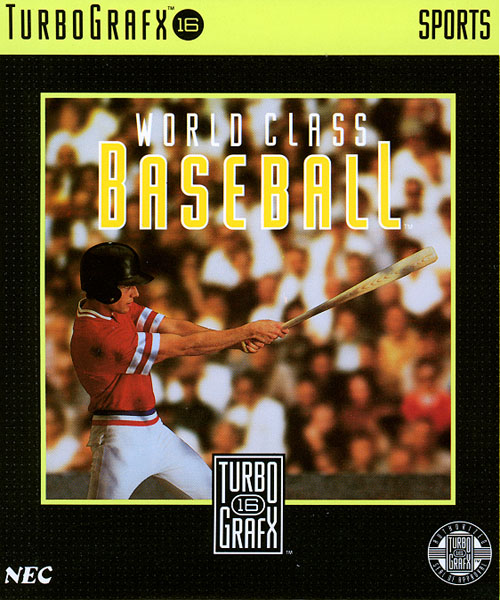
This blog is steadily marching on through history of baseball video games. We are now in the year 1989 and many new systems are now available. One of the new platforms is the short lived, TurboGrafx-16. I believe World Class Baseball for the TurboGrafx-16 is the only baseball game released in the United States. I should mention that even though 1989 is bringing us 16-bit gaming, the little system that could from the 70's, released it most advanced baseball game as well. I am referring to Pete Rose's Baseball for the Atari 2600 and 7800. Sadly I do not have a copy of the game so it is not included in this blog series at this time. Pete Rose Baseball was not really innovated in terms of baseball games go but compared to their 1978 Home Run game; it is amazing feat to still be able to produce quality games more than 10 years after its launch. It is too bad that in 1989, people traded in their Atari 2600 for a TurboGrafx-16 or Sega Genesis and Pete Rose Baseball did not do well in retail. Was the trade considered world class?
Graphics
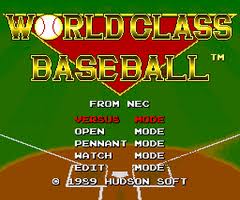
This is the first 16-bit baseball game in this blog series and from a graphics perspective; it is easy to see the importance of 16-bits compared to 8-bits. We can begin to see more textures and an increase color palette. The text is more readable as well as the baselines are very crisp and not jaggy. Regarding the text, the font has a nice thin black outline to them which make it pop up and not cause color bleeding. The B/S/O counts use different colors but oddly the arrangements of the three counts in the game are non-standard. The game lists it as S/B/O.
Field
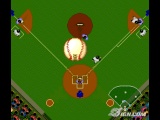
The field in the game resembles that of an astroturf field; the infield only has dirt around the bases for sliding but not along the base paths. The behind the batter view shows lawnmower lines in the field as if it was freshly mowed before the game. It is a nice graphical innovation and helps provides the gamer a sense of realism. The field contains the on deck circle, base path for first base, base coach boxes as well as base coaches. While I do like the fact they included the base coaches in the game, I found them more of a distraction than a nice graphical touch to the game. Maybe it was the camera angle or maybe because they look 100% like a base runner but I found myself throwing to a base because I thought I saw a base runner off the base only to realize it was the base coach just standing there. I think it would help the gamer if they added some separation between the coaches on the field vs the players on the field of play. I don’t find the umpires distracting because they are often wearing blue or black.
Players
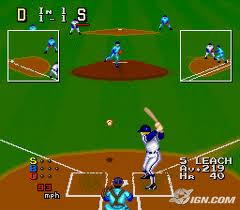
The behind the batter view has steadily gained improvements on the rendering of the players. The uniforms are now detailed, the batter has a helmet and the stirrups are very pronounced part of the uniform. The batting swing is also fluid and smooth. The catcher's straps are also well detailed. A new batter’s animation is introduced in this game. No longer do we see the batter sprite slide around in the batter’s box as we move him. The legs actually move like a human is expected to move. While the behind the batter view is detailed the overhead view sort of lacks detail. The overhead view is slightly boring and something an 8-bit platform can easily handle. During the fielding, the players all look the same and very generic. The game does not include the real MLB teams nor are players; the teams are made up so I can’t comment on how they compare to the real life players.
Scoreboard
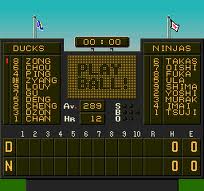
The scoreboard in this game looks very nice. The jumbotron is made up of small light bulbs that give it that pixilated look to video that you would actually see in baseball parks in the late 80’s. Scoreboards back then were just starting to get electric and video and you won’t actually see huge TV screen resolutions on scoreboards till the late 90’s. The scoreboard displays each team’s lineup and an indicator on who is up to bat as well as the current batter’s avg and homerun count. It does lack any information about the current pitcher however. The inning summary is displayed up to 10 innings as well as the game total runs, hits and errors. One thing I did notice is that inning run count was incapable of displaying double digits. I had 12 runs scored on me in the 8th inning one time and it only displayed ‘2’. FYI… there is no mercy run in this game.
Fans
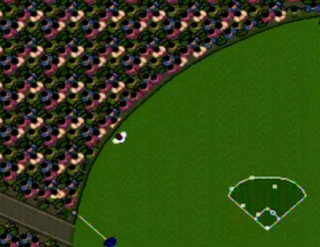
We continue to progress regarding the crowd in baseball video games. Here we see individual fans in the crowd as well as the seats they sit in. The crowd pattern for this game includes empty seats which is more realistic. All the fans have the same color hair, but different color shirts. They are all the same size as well.
Home Run Celebration
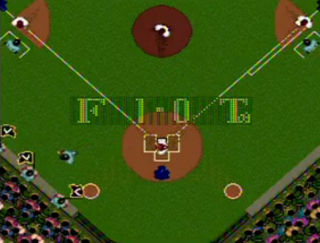
I would say only 2 bits of the 16 bits of the game was required to produce the home run celebration. The words ‘Home Run’ appear in the center of the screen as the ball lands in the stands. When the ball hits the stands however the ball didn’t disappear but rather continue to get smaller until it runs off screen, it was a weird effect that didn’t match the camera’s top down perspective. The camera stays with the crowd until the batter runs down the third base line and connects with the plate. The runner then goes back to his dugout where you see his teammates waving flags as he stands in front of them and waves his hands to the crowd. The celebration within the dugout is enjoyable to watch and hearing the home run melody is always fun to hear.
Camera/Screens
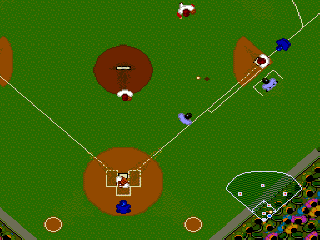
This game introduces a true top down perspective during the fielding. You only see the player’s helmet/hat and shoulders. The hands and feet pop in and out of the sides of the player while they run or throw. The catcher is rendered differently in the overhead due to the straps for his pads, nice touch. The camera switches to this top down camera during strikes out which lets us see the next batter approaching the batter’s box. Gone are the days in which the next batter just appears.
Menu
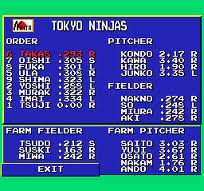
As we march through video game history, new concepts begin to emerge. The last entry we created a section for the scoreboard now we have enough history to compare and contrast the menu system within the baseball games. The menu system includes the process to pitch hit, modify lineup and or roster. The menu system in this game is very easy to navigate. As typical from previous games, the background for the roster management is solid blue with white text.
Sounds
The melody and background music is really nice and catchy. When there is a runner in scoring position the music’s tempo picks up a little bit. The melody between innings was also pleasant. The umpires voices were not very impressive and sounded muffled.
Gameplay
Modes

Three standard modes and one new mode for baseball video games are included in this game
- Versus Mode – 2 player single game
- Open Mode – 1 player single game
- Pennant Mode – 1 player tournament mode where at the end you play against the Turbo Tigers for the championship
- Edit Mode – This mode enabled the player to edit the team’s roster before you play. This is a great innovative mode and a great stepping stone for baseball video games. For the first time we can manage teams and not only the lineup but the general team roster including numerous players from the farm team/minor league that you can bring up and put in the lineup or have them selectable to pitch hit. I found myself enjoying editing the teams trying to invoke some baseball strategy into the teams
Defense
When fielders picks up the ball, he cannot freely move only able to move in a set path to a base or throw the ball to one of the bases. If you select a base to throw to and there is a fielder along the path of the ball, they catch the ball which forces you to throw the ball again to reach the base you intended in the first place. The best example of this is when you spot a runner stealing 2nd base, as a catcher you attempt to throw to 2nd base but the pitcher is in the middle of the throw and intercepts the ball. I ended up having to make the throw and then move the pitcher out of the way. This is not natural and really hinders the gameplay. It is not a deal breaker and something if played long enough will become something you just know you have to do. I feel throwing the ball is a tad slow; I feel the runners can run faster than the throw which makes double plays a rare thing. The fielding overall is really bizarre. It seems like we are back in the late 70's where you are controlling fielders as a unit, Which sort of worked in the old days when the whole playing field was displayed at once but when a ball zips through the infield and in the outfield it is frustrating, at point you are moving the infield up but then switch to the outfield and move the players down. I had to mentally think that the fielder I am really should be controlling is the outfielder that isn't in view yet. I found myself focusing on the small picture in picture of the field more than the main camera to get an idea on where I need to move
Offense
I didn’t have many problems with the offensive side of the ball. The batting was nice and fluid. I felt I was able to move the batter where I wanted and make contact with the ball. I did however notice that controlling base runners is my weakest part of my game. When the bases are loaded chances are I will screw it up and get a runner caught in a run down. This is not a knock on the game but more on my inability to control 4 baseball players at the same time. The base running mechanic is the same as the 8-bit version of the sport. This is due to the system having the same number of buttons and options.
Rules of Baseball
This is truly a gem of a video game regarding the aspects of baseball. The ability to edit a roster as well as the lineup really puts you in control of your team. The teams and players are not licensed by MLB or any established league so there is no joy of playing as your favorite player. The players didn’t have numbers on the backs of the uniforms which I missed.
Video Game Innovations
- Edit Rosters, Minor league/farm system
- Top Down Perspective
- Lawnmower lines in field
- Empty seats in the crowd
- Ball enlarged as it approaches the camera
- Batter moving legs as moves around the batter's box
- View the batter approach home plate
- Picture in picture of the field includes the fielders and not just the diamond
Thanks, If you were wondering about the line up of games for the blog series. I have setup a list of the games in the order when they will appear. http://www.giantbomb.com/profile/jbn566/baseball-history-2012/46-73033/
This is a series of blogs based on my own personal game collection. I will attempt to go through them in a chronological order according to their release date. I will also attempt to play then on their original platform using the original controllers the game was designed for. If I am unable to get the system or the game working then I will use PC emulation or another platform emulation like the Intellivision Lives! game for the gamecube
Previous entries
| 8. Intellivision's World Championship Baseball (1983) 9. Sega Master System's Great Baseball (1987) 10. Nintendo's Bases Loaded (1987) 11. Nintendo's R.B.I Baseball (1988) 12. Nintendo's Major League Baseball (1988) |
Reggie Jackson's Baseball for Sega Master System (1988)
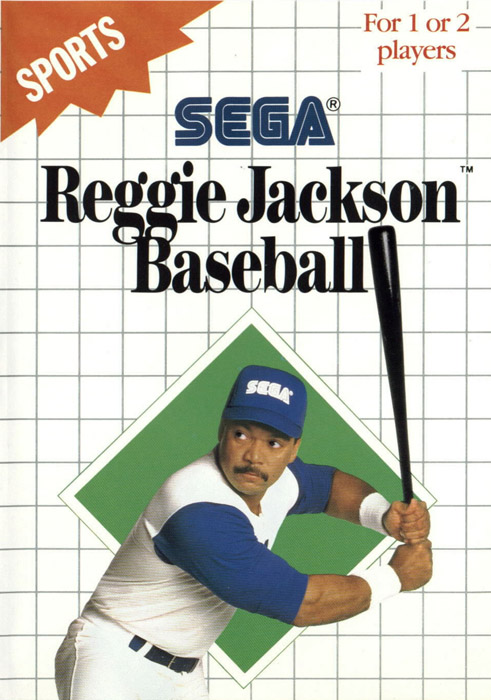
While the Nintendo gamers had three baseball games to play, the Sega Master fanboys only had 1 until Reggie Jackson's Baseball was released. You can make the argument that Reggie Jackson is a sequel to Great Baseball released in 1987 or a proof of concept for their Genesis game to be released in 1989. Gone is the behind the pitcher view; In is the behind the catcher view. Reggie Jackson was an extremely popular baseball player in the 70's and early 80's. Maybe not intently but Reggie Jackson retired from the sport in 1987, a year before this game was released. This fact makes this game the first video game console game to be named after a MLB player as well as a retired MLB player. Reggie was a power hitter for many teams; does this game have the power to earn itself a home run?
Graphics
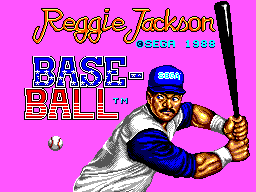
This game is a step up from Great Baseball released just a year prior for the Sega system. While Great Baseball had animations on the jumbotron, this game improves on the concept. I don't want to be viewed as a caveman but when I play a baseball game, I could use a little less pink in my game. The color of salmon is spotted all over this game; the pennants, the icons for the Ball/Strikes/Out, the title screen as well as the team uniforms. I will assume Reggie Jackson demanded the color thus not darn to question his judgment. This game is a good example that the Sega Master System might have better graphics capabilities of the NES but just lost the race for market share.
Field
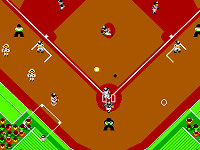
I can't ignore a weird innovation this game provides the player and that is when you start a game of baseball, the color of the field is randomly selected. The color of the grass you end up playing on is red, green or yellow. If you were wondering why this concept never became a staple feature in future baseball games, press the reset button until you get the red field and have fun. If you can look beyond the color of the field, this game includes nice additions to baseball video games that exists in real life such as base coaches, batter in the on deck circle, relief pitcher warming up near the dugout, relief pitcher golf cart, warning track along the outfield wall and of course cheerleaders... Yes this game has cheerleaders, this game is that innovated. Also I have to point out that during the pitch the field and dirt around the batter's box contains some textures and has a 'used' look which I found refreshing.
| Red Grass | Green Grass | Yellow Grass |
|---|---|---|
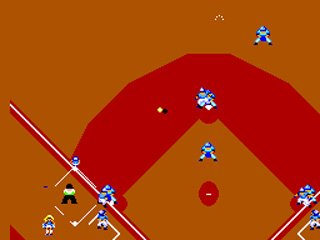 | 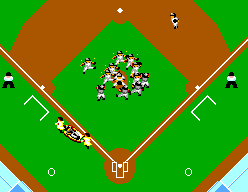 | 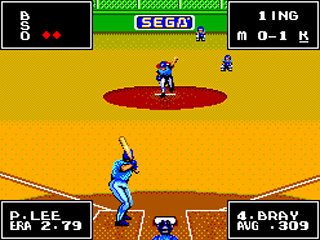 |
Scoreboard
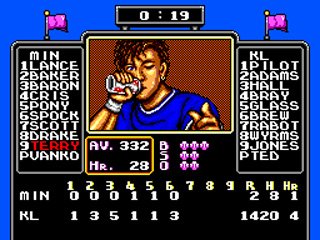
I have decided to add a new subcategory which details the scoreboard. We are now at a point along the baseball video game history timeline where the scoreboard is the center of information regarding the game. As with the Great Baseball prior, this game included cartoony animations on the scoreboard for entertainment value as if you were watching a real baseball game. The scoreboard includes the lineup of teams, the Balls/Strikes/Outs, BSO, as well as the run summary of every inning including a game summary of total runs, hits and home runs as well as a running game time. It shows the current batter's average and home run count.
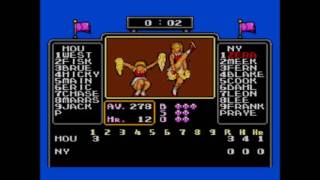 | 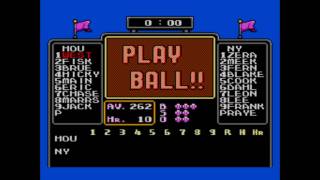 |
Players

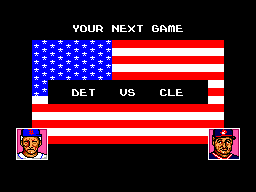
As many innovations this game provided regarding the field, It doesn't provide the same level of innovation regarding the players. The batter is nicely rendered and we can see the pinstripes down the pants as well as the pitcher animation of waving off the catchers signs. Once the ball is hit the players are less detailed. The color schema of the uniforms between the defense and offensive makes it hard to tell which is which during infield plays. One of the player innovations is the each team includes a profile picture of the manager. The image of the managers resembles the actual team managers during the 1987 MLB season.
Fans
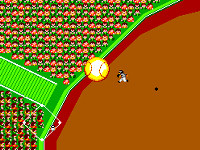
Always appears to be the weakest section of the blog, I am happy to report that we can see a slight improvement regarding the crowd with Reggie Jackson's take on baseball video games; Thank you Reggie, Thank you. The crowd includes various shaped individuals. Well only their neck and face but at least it is a step in the right direction. They even have hands that appear to clap and they move their face side to side. The crowd is just a duplicated pattern to fill all the seats
Home Run Celebration

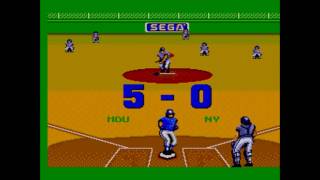
Good thing the game's home run celebration is fun because It happens a lot. Once the ball disappears, a popup widows shows up and nice big words "Home Run" in a typical wireframe 80's 3D effect. Like Bases Loaded before it, every home run includes a nice cartoon animation. Unlike Bases Loaded it occurs when the runner touches home plate instead of when rounding second base. I am not familiar with Reggie Jackson's playing days but the runner looks more like David Ortiz then Reggie Jackson. As he approaches home plate, he stops and then proceeds to jump and stomp on home plate as he flexes his muscles. Nice touch when you are the one who hit the home run, annoying if you are the pitcher.
Camera/Screen
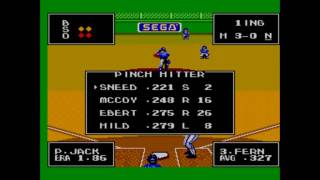
Instead of using the scoreboard to manage the pitch hitting and change of pitchers, a separate popup window appears listing the various players that can be selected. The batting is done by the behind the batter viewpoint and it appears as well the behind the pitcher view of Bases Loaded is quickly becoming an oddity and not the standard or expected viewpoint that gamers want. One aspect regarding the camera that spices the genre up is when the ball is in the air, the ball grows in size as if the ball was approaching the actual camera above the field. The side effect to that is the shadow of the ball is positioned to the side as if simulating a real light source. My problem for the shadow is I have grown up with the 'Nintendo Shadow Rule' where an object's shadow in a video game does not exist to show lighting effects but to help the player understand where the object is located within the space of the game. The shadow in this game is distracting and is hard to gauge where it might land.
Sound
Not much to the sound of the game. The background music is only 3-5 notes and repeats itself. The umpire has a nice voice to it and even says words like "Strike Out” We can hear the umpire in video games are increasing being more vocal and an increase their vocab.
Gameplay - Modes
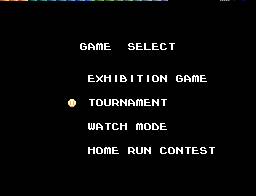
Standard Modes
- Exhibition Game - 1 or 2 player. Each game you have the option for auto-fielding or manual.
- Tournament - compete in a pennant race
- Watch mode - Watch the CPU play the game of baseball. During the off season this is a good way to watch your favorite team compete?
- Home Run Contest - 20 pitches down the line.
FYI I am looking forward to seeing which game is the first to have a career mode. Bases Loaded is the closest with having an 80 game season. If I had my choice I would ask the developers to get rid of Watch mode and put that freed up space towards career mode.
Gameplay - Defense
The addition of the warning track near the outfield wall is not just a graphical improvement but also a gameplay element. The ball when it rolls or hits the warning track slows down and behaves differently than the outfield grass. Speaking of fielding, this game lets you manually control the outfield or have the CPU control the positioning. You still have control of the fielder once he collects the ball and you can run with the ball or throw it a base by pressing a direction on the dpad and pressing B. I noticed the field is really big, there where hits that landed in the grass and nothing was in the screen with me besides the ball. The pitching ability is par for the course for the late 80's video game. You have control of the ball as it floats towards home plate. A defensive baseball concept makes it's appearance in this game and that is the ability to have a fielder jump to try to grab the ball in the air.
Gameplay - Offense
I mentioned previously but It appears as though Home Runs are very easy to make, thus making this an offensive focus game. I am not surprised given Reggie Jackson wasn't known for his defense plays. The batter in the game cannot move up and down in the box only left and right, which is opposite of the last game in the series. Like NES's Major League Baseball before, I didn't find this gameplay limitation effect my ability to hit the ball where I want it. I felt I was able to pull the ball etc... Base running was just as easy to execute as hitting the ball. After a few tries I was able to steal bases with ease.
Rules of Baseball
I was unable to edit my lineup and roster so I feel we have gone backwards regards to becoming a team manager. The game is a solid baseball game. It does a nice job of highlighting big plays by zooming in at home for example. This provides that sense of thrill during baseball games that is mostly missing from the video game versions of the sport. Another thrill of a baseball game is what happens when a batter is hit by the pitch; not only does the batter kneel down in pain but the camera it switched to the bird's eye view and both dugouts empty as the game medics carry the batter off the field. It's pretty nuts, oh Reggie.
Video Game Innovations
- Base Coach visible
- Relief Pitcher/Catcher warming up on the side
- Cheerleaders and Mascot
- Different color grass
- Warning Track
- Crowd with hands that clap
- Animations for close plays
- Dugout empty brawl
- Fielder can make a jumping catch
oh yea, trust me MLBPA Baseball is 100% going to be included in series. MLBPA Baseball is by far my most played baseball game . To this day I can remember the title screen and when the camera scrolled through the outfield grass. I don't actually have the Roger Clemons game so I can't include it in my blog series. I am trying to stick with only games I actually own the cartridge for. Maybe by the time I hit the early 90's I can find a copy on amazon or ebay and play it.
Yea eventually I probably want to take the information I have and apply them to the game's wiki. The one positive thing about the blog vs the wiki is the structure of it. I am able to take aspects of the game and apply it across all the games. I feel the blog format lets me do a better job of compare and contrast, each blog includes the same sections. With the wiki it is up to the community and more loose in terms of what content can be included. I am als waiting to see what the redesign of the wiki is going to look like before I do a mass data entry of various baseball games. Maybe the redesign will provide additional editing tools to help authors create standard metadata regarding a genre.
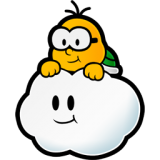
Log in to comment